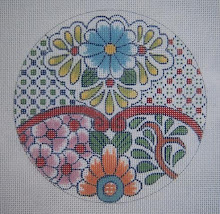 Threading a tapestry needle for needlepoint has been such an automatic action for me for so many years, I tend to forget that some people haven't experienced anything yet but threading a sewing needle with more manageable threads.
Threading a tapestry needle for needlepoint has been such an automatic action for me for so many years, I tend to forget that some people haven't experienced anything yet but threading a sewing needle with more manageable threads. When I was first taught to do needlepoint, I was fortunate to have been shown the very easy way to thread a needle with Persian wool, which is what we used 140 years ago when I was young.
In the last few weeks, I have actually had several people ask me for an easy way to do this - something I just take for granted and don't think about. However, I do remember having ladies in beginners' classes who tried to moisten the end of the thread with their tongues, as we did sewing thread, and complaining about a lot of fuzz in their mouths. Not necessary, I'm happy to say.
The first photo shows needle threaders. On the left is a wire threader which is included in a package of beading needles - it's rather flimsy, and doesn't last long, even with just the cotton floss I use for beads on needlepoint. The center threader is quite sturdy, and even has the big hole for use with large eye tapestry needles and rug yarn. I usually just safety pin this one to my canvas so it doesn't go astray. On the right is another wire threader, but this one, purchased from Colleen at the NeedleWorks here in Austin, lasts quite a while - amazing in its durability!! These are available in packages of two.

The next photo illustrates the usual way to thread a needle for needlpoint: Simply pull the thread around the end of the needle tightly, then remove the needle and pinch the thread loop down between thumb and forefinger until it disappears. Then, when you allow it to pop back up, it will go right through the eye of the needle - quite easy when you've had practice!!
NEVER use a tapestry needle that's bigger than should be used on the size canvas you're working on, as that will also distort the holes in the canvas and ruin the beauty of your stitches. I've seen this suggested, in order to have a larger eye to work with, but it's counter-productive and not necessary.
A word about this - I use the John James tapestry needles, and there is one that's called "Tweens" - a size 21, which is between the size 20 I use for 13 mesh, and the 22 normally used for 18 mesh. I like this size 21 for 18 mesh canvas.
 (Also available from Colleen)
(Also available from Colleen)The next two pictures illustrate the "pinching" the thread to disappear, and then letting it pop right through the needle's eye. Try it - it will make your life easier.

The last desparate measure, when all threaders have been lost in the carpet or on the floor of the car, and the thread is too fuzzy or fat for pinching, is to simply cut a little paper triangle, fold in half and insert the end of the thread. Then push the point of the triangle through the eye of the needle far enough to pull the thread on through - and remove the paper.


I often use the paper method when I'm teaching children - they seem to pick it up quickly and it means less work for the helpers threading needles.
ReplyDeleteOne tip I read somewhere (and I can't remember where) was to do with the metal needlethreaders in the first picture. If you put a drop or two of superglue or similar where the wires enter on the back and allow to harden they will last much longer.
Jacqui (in Auckland, New Zealand)
Many thanks for that, Jacqui - I already looked at the back of my little metal threader, and ran for the super glue. Panic is when it breaks, and I haven't another spare, and a beading project is in progress.
ReplyDeleteThank you for these hints. I am always licking the end of my thread and getting fuzzes. This is wonderful!!!!
ReplyDeleteHi Judy,
ReplyDeleteYes!
Thanks so much for putting this online as the pinching technique is what I teach! As I always say, No Licking and Poking in my classes!
Cynthia
Windy Meadow